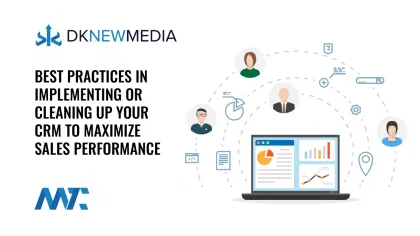The 4 Steps To Implement Or Cleanup CRM Data To Maximize Your Sales Performance

Companies that wish to improve their sales performance typically invest in implementing a customer relationship management (CRM) platform. We’ve discussed why companies implement a CRM, and companies often take the step… but the transformations frequently fail for a few reasons:
- Data: At times, companies opt for a data dump of their accounts and contacts into a CRM platform, but the data is often not clean. If they’ve already implemented a CRM, they may also find the data frustrating and incapable of producing a return on investment (ROI).
- Process: For sales to truly leverage a CRM, a process must be in place that drives the qualification of leads and prioritizes current accounts. Companies need a methodology to prioritize leads and accounts with the most opportunity.
- Assignments: New leads and existing accounts must be assigned to the CRM appropriately, either manually or through territory rules. Without an assignment, there is no means to drive sales activity.
- Reporting: Accurate, transparent, and believable reporting must be implemented for both your sales team and leadership team to adopt a CRM readily.
- Updating: To maintain data accuracy and fully realize your return on investment, the automation, integration, and manual update processes for your CRM must be implemented. Without updating CRM, reps abandon the platform, and leadership fails to depend on it.
Step 1: Preparing Or Cleaning Your CRM Data
Account data may be within your current CRM, a CRM you’re migrating from, a billing system export, or even just a bunch of spreadsheets. Either way, we often discover a ton of bad data that requires cleanup. This includes, but isn’t limited to, dead accounts, contacts that no longer exist, acquisitions, duplicate accounts, and unstructured accounts (parent/child relationships).
Steps that can be taken to analyze and fine-tune your data include:
- Validation: Utilizing third-party data cleansing tools on company firmographic data as well as contact data to validate, cleanse, and update your current data. This will ensure that your team and processes can focus on accurate information rather than wading through bad data in the CRM.
- Status: Identifying the current status of accounts, activity, associated revenue, assigned salesperson, buyer’s stage, and contact is a crucial step in isolating records that your CRM should focus on, rather than importing a large amount of contact and account data that is useless.
- Hierarchy: Accounts often have a hierarchy associated with them. Whether it’s a corporation with independent offices, a household with multiple customers, or
- Prioritization: Exporting transactional revenue associated with your accounts is an ideal way to assign recency, frequency, and monetary (RFM) metrics to prioritize based on the propensity to purchase. This methodology isn’t often included in a basic CRM and typically requires an external tool to analyze and score.
- Territory: How are your salespeople assigned to an account? Companies often have industries, regions, or even an assignment based on the size of the company to pair their best sales representatives to the appropriate account. As you import your CRM on an implementation or work to clean up your existing account, you’ll want to ensure this assignment process is vetted so opportunities don’t go unnoticed.
At times, companies we’ve worked with have even limited the number of accounts and sales personnel they’ve working with their CRM. An implementation based on key accounts, for example, can drive a ton of business rather than trying to roll out to the entire organization. This can provide the case study that other teams need to see the value of your CRM.
Your personnel may often determine your rollout success… marketing and sales teams that are tech-savvy will usually drive usage and a rapid ROI of the CRM you deploy, rather than a disengaged workforce.
Step 2: Building Your Integrations to CRM
A CRM without integrations places a significant burden on your staff to manage and update. It’s not a requirement to integrate your CRM, but it’s highly recommended that you evaluate your systems to determine the capabilities you have to enhance your CRM data.
- Leads: All entry points for leads should be integrated into your CRM, along with all required data and the referring source from which they originated.
- Enhancement: Any third-party platforms to enhance the account data with firmographic and contact-level information that can help your qualification and sales process.
- Touchpoints: any touchpoints you have that assist in the buyer’s journey. This could be site visits, phone dialing systems, email marketing, quoting systems, and billing systems.
Activity is critical to optimizing your sales process within a CRM, and often, simple integrations are overlooked that could dramatically assist your marketing and sales teams in improving performance. A data discovery is an ideal way to document and identify opportunities for automating your integrations and any automation to synchronize systems with your CRM.
Step 3: Executing Your Sales Strategy With CRM
Now that you’ve got fantastic data, the next step is understanding your buyer’s journey so that you can accurately:
- Determine what a marketing qualified lead (MQL) is to assign a lead to a sales representative.
- Determine what a sales qualified lead (SQL) is to identify a lead is, indeed, a customer worth pursuing.
- Build your initial sales process to identify actionable steps by your salesperson to advance the lead to an opportunity. This could simply be an introductory phone call to share your products or services or a demonstration of your product. This is a process that should be continuously optimized over time.
- Apply your sales funnel steps to your existing accounts and assign the action steps for your sales representatives to engage with your prospects.
- Ensure that you have a sales funnel dashboard that provides both a visualization and insight report into your accounts.
- Ensure that you have a performance dashboard that provides both a visualization and insight report into sales representatives’ activity so that you can coach and advise them.
This phase kicks off the execution of your new sales process and it’s critical that you are engaged with your team to identify any outstanding issues that are creating roadblocks to their success in utilizing the CRM to prioritize and accelerate their sales activity. At this point, building behaviors and habits to use the CRM are critical.
Many companies have set up their CRM, they have sales processes and training in place to ensure people know what they are expected to do in CRM to manage their opportunities effectively. The problem I see often is that people just don’t do what they are supposed to do and have been trained to do. Our program can drive and measure adherence to these behaviors. In other words, the ability to manage an opportunity through various stages of a company’s sales process is in place, however, users and managers choose (directly or indirectly) to not hold themselves or their employees accountable for actually logging the information into the system as the opportunity progresses in a timely and consistent manner.
Ben Broom
Step 4: Performance Monitoring and Coaching
A typical engagement of our company to assist customers (most notably Salesforce) in gaining a return on their technology investment starts with Steps 1 through 3… but customers who see the greatest return are in ongoing engagements with our team to develop a continuous improvement cycle where we:
- Lead Scoring: We implement manual or automated processes that integrate RFM into their overall lead process to help the sales team focus their attention on their greatest acquisition and upsell opportunities.
- Sales Representative Performance: We provide our clients with both performance reporting and professional development to drive performance at an individual and team level.
- Sales Leadership Development: We provide our clients’ sales leaders with the reporting and professional development to drive the performance of their sales representatives and teams.
- Organizational Reporting: We develop reporting for senior leaders within an organization (outside sales and marketing) to understand current performance as well as predict future growth.
Some companies can adapt and do this themselves, but it often requires a third party to provide the assessments, tools, processes, and talent to realize their CRM investment fully.
Defining CRM Success
Your CRM investment isn’t fully realized until you have these 3 goals met:
- Transparency: Every member of your organization can view real-time activity within your marketing and sales processes within your CRM to understand how the organization is working towards its growth goals.
- Actionability: Your marketing and sales team now has actionable activity and goals assigned that assist them in accelerating your organization’s marketing efforts and sales growth for the future, not just the next quarter.
- Believability: All members of your organization believe in the data they are accessing and understand that their investment in a CRM enables them to accurately analyze, evaluate, plan, optimize, and predict their sales and marketing outcomes.
Another issue with CRM implementations is that sales organizations are typically aligned culturally with hitting their numbers for each quarter or the end of the year. As a result, CRM is turned into a short-term focus while their customers’ buying cycles may be multi-year. Actionability isn’t just about meeting the next compensation quota; it’s about leadership embedding a culture of nurturing and activity that will enable the company to grow its sales funnel for years to come.
It’s not one or the other of these goals; all three must be met before an organization sees a return on its technology investment in a CRM.
CRM Data Cleanup Consultants
If your company is migrating to a CRM or struggling to realize the full potential of your current CRM, please don’t hesitate to contact me for assistance. We have a proven process, the tools, and the team ready to assist any size organization. We’ve worked across many CRM software suites and have exceptional experience in Salesforce Sales Cloud.







